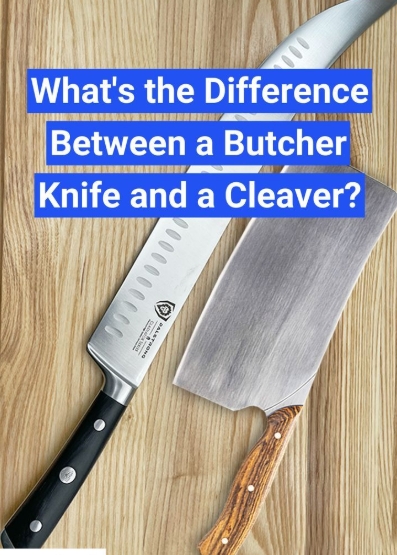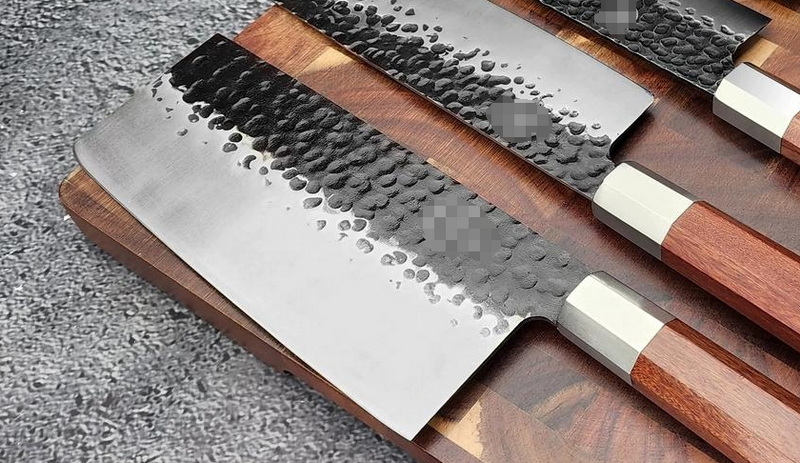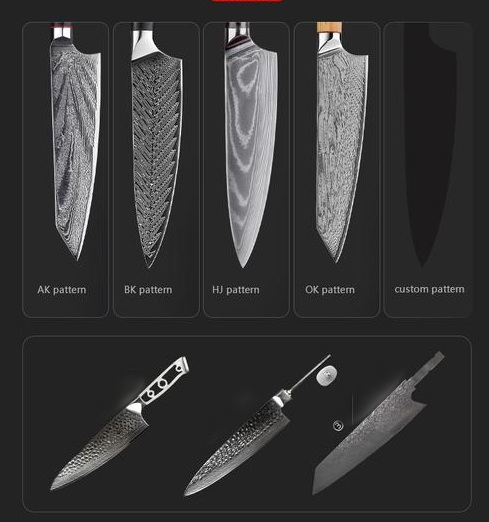

Views: 222 Author: Ella Publish Time: 2025-04-29 Origin: Site








Content Menu
● The Myth of the Mega Knife Set
● The Essential Kitchen Knives
>> Chef's Knife: The Workhorse
>> Paring Knife: Precision and Control
>> Serrated (Bread) Knife: For Crusty and Delicate Foods
>> Utility Knife: The In-Between
● Nice-to-Have Knives (But Not Essential)
● How Many Knives Do You Really Need?
● Understanding Knife Materials and Construction
● How to Choose the Right Knives
>> Consider Your Cooking Habits
● Knife Skills Every Home Cook Should Know
● When to Add Specialty Knives
● Frequently Asked Questions (FAQ)
>> 1. What are the three most essential kitchen knives?
>> 2. Is it worth buying a large knife set?
>> 3. How often should I sharpen my kitchen knives?
>> 4. What's the difference between a chef's knife and a Santoku knife?
>> 5. How should I store my kitchen knives?
Walk into any kitchenware store and you'll be dazzled-and maybe overwhelmed-by the sheer variety of kitchen knives. From massive chef's knives to delicate tomato knives, the options seem endless. But do you really need a block filled with a dozen blades, or can you cook like a pro with just a select few? This comprehensive guide will help you cut through the clutter, understand what each knife does, and decide exactly how many kitchen knives you truly need for your home kitchen.

Many home cooks start out with a large set of knives, often gifted or bought on sale. These sets can include 10, 15, or even more knives, each designed for a specific purpose. However, most people end up using only a handful of them regularly while the rest gather dust in a drawer or knife block. The truth is, unless you're a professional chef or a knife enthusiast, you don't need a vast collection to handle everyday cooking tasks.
The chef's knife is the undisputed king of the kitchen. With a blade typically ranging from 6 to 10 inches, this versatile knife is perfect for chopping, slicing, dicing, and mincing almost anything-vegetables, fruits, meats, and herbs. If you could only own one knife, this would be it. Its curved blade allows for a rocking motion, making it efficient for both precision and power cuts.
A paring knife is small, usually with a 3-4 inch blade, designed for tasks that require precision, such as peeling, trimming, and cutting small fruits or vegetables. It's the go-to tool for jobs where a chef's knife feels too large or unwieldy. The compact size makes it ideal for intricate work, like deveining shrimp, segmenting citrus, or hulling strawberries.
A serrated knife, often called a bread knife, features a long blade with saw-like teeth. It's essential for slicing bread, cakes, and foods with tough exteriors and soft interiors, like tomatoes or melons. The serrations grip and cut through crusts and skins without crushing the soft insides. This knife is not only for bread; it's also excellent for slicing delicate pastries or even carving roasts with a crispy outer layer.
A utility knife bridges the gap between the chef's knife and the paring knife, typically with a 4-7 inch blade. It's ideal for slicing sandwiches, cutting medium-sized fruits and vegetables, and handling tasks that are too big for a paring knife but don't require the heft of a chef's knife. Its versatility makes it a favorite for quick jobs and smaller hands.
Once you have the basics, you can consider adding specialty knives as your cooking skills and needs grow. Here are some options:
- Boning Knife: For removing bones from meat and fish.
- Carving Knife: For slicing roasts and large cuts of meat.
- Santoku Knife: A Japanese all-purpose knife, great for vegetables and precise cuts.
- Nakiri Knife: A Japanese vegetable knife with a straight edge, ideal for chopping.
- Cleaver: For chopping through bones and tough vegetables.
- Fillet Knife: For filleting fish.
While these knives can make specific tasks easier, they're not necessary for most home cooks. It's best to acquire them as your cooking repertoire expands and you find yourself needing more specialized tools.
For the average home cook, a set of three to four knives is sufficient:
- Chef's Knife
- Paring Knife
- Serrated (Bread) Knife
- Utility Knife (optional, but useful)
These knives will handle virtually all kitchen tasks, from prepping vegetables to slicing bread and peeling fruit. If you bake bread frequently, a serrated knife is essential. If you do a lot of intricate work, the paring knife will be your best friend. For everything else, the chef's knife has you covered.
The material of a knife's blade affects its sharpness, durability, and maintenance. The most common materials include:
- Stainless Steel: Resistant to rust and staining, easy to maintain, and affordable. Most home cooks will find stainless steel knives practical and reliable.
- High-Carbon Steel: Holds a sharp edge longer but can rust if not properly cared for. These knives are favored by professionals for their edge retention.
- Ceramic: Extremely sharp and lightweight, but brittle and prone to chipping. Best for light tasks and not for cutting bones or frozen foods.
- Damascus Steel: Known for its beautiful, wavy patterns and excellent performance. Often more expensive, these knives combine aesthetics with functionality.
A well-constructed knife will feel balanced and sturdy in your hand. Look for:
- Full Tang: The blade extends through the handle, providing strength and stability.
- Forged vs. Stamped: Forged knives are made from a single piece of steel and are generally stronger, while stamped knives are cut from a sheet of metal and are lighter and less expensive.

- Minimalist Cook: Stick to the essentials-chef's, paring, and bread knife.
- Avid Home Chef: Add a utility knife and one or two specialty knives tailored to your favorite dishes.
- Enthusiast or Collector: Explore Japanese knives, cleavers, and other specialty blades as your interest grows.
Invest in a few high-quality knives rather than a large set of mediocre ones. A well-made knife will last longer, perform better, and be safer to use. When choosing a knife, consider the handle comfort, blade balance, and ease of sharpening.
Proper knife safety is crucial for both beginners and experienced cooks. Here are some essential tips:
- Always cut on a stable, non-slip cutting board.
- Keep your knives sharp; dull knives are more dangerous because they require more force and are more likely to slip.
- Use the right knife for the job to prevent accidents.
- Store knives safely, either in a block, on a magnetic strip, or with blade guards.
- Never try to catch a falling knife.
- Keep your fingers curled under when chopping to avoid accidental cuts.
Proper care and maintenance will extend the life of your knives and ensure they perform at their best:
- Hand wash and dry immediately after use.
- Never put knives in the dishwasher.
- Store knives on a magnetic strip or in a protective sheath, not loose in a drawer.
- Use a honing rod regularly to maintain the edge.
- Sharpen your knives as needed, either professionally or with a whetstone.
Taking care of your knives not only preserves their sharpness but also keeps your cooking experience enjoyable and safe.
Mastering a few basic knife skills can make cooking faster, safer, and more enjoyable:
- The Rock Chop: Use the curved edge of the chef's knife to rock back and forth for fast chopping.
- The Claw Grip: Tuck your fingertips under and grip the food with your knuckles facing the blade, protecting your fingers.
- Julienne and Dice: Learn to cut vegetables into matchsticks (julienne) and cubes (dice) for uniform cooking and presentation.
- Slicing Bread: Use a gentle sawing motion with a serrated knife to avoid crushing the loaf.
Practice these techniques with the right knives, and you'll notice a significant improvement in your prep work.
As your cooking repertoire grows, you may find a need for specialty knives. Here are some scenarios:
- If you frequently break down whole chickens or fillet fish, a boning or fillet knife will make the task easier and more precise.
- If you host large gatherings and carve roasts or turkeys, a carving knife can help you achieve thin, even slices.
- If you enjoy Asian cuisine, a Santoku or Nakiri knife can be a valuable addition for precise vegetable work.
Remember, these knives are not essential for everyone. Add them as your cooking needs evolve.
Proper storage protects your knives and keeps your kitchen organized. Here are some popular options:
- Knife Block: Convenient and keeps blades protected, but can take up counter space.
- Magnetic Strip: Saves space and allows for easy access, but requires wall installation.
- Drawer Inserts: Keep knives organized and out of sight, but ensure the insert fits your drawer.
- Blade Guards: Useful for storing knives in a drawer or when transporting them.
You don't need a drawer full of knives to cook like a pro. For most home cooks, three to four high-quality knives-a chef's knife, a paring knife, a serrated bread knife, and optionally a utility knife-will handle nearly every kitchen task with ease. Specialty knives can be added as your cooking skills and interests evolve, but start simple and invest in quality. With the right knives and proper care, you'll slice, dice, and chop your way to better meals and a more enjoyable cooking experience.

The three most essential kitchen knives are the chef's knife, the paring knife, and the serrated (bread) knife. These cover nearly all basic kitchen tasks, from chopping vegetables to slicing bread and peeling fruit.
For most home cooks, a large knife set is unnecessary. You'll likely use only a few knives regularly. It's better to invest in a few high-quality knives that you'll use daily.
The frequency depends on use, but generally, you should hone your knives every few uses and sharpen them professionally or with a whetstone a few times a year. A sharp knife is safer and more effective.
A chef's knife typically has a curved blade suited for rocking motions, while a Santoku has a flatter edge ideal for up-and-down chopping. Both are versatile, but the chef's knife is more common in Western kitchens.
Store knives on a magnetic strip, in a knife block, or in protective sheaths. Avoid storing them loose in a drawer, as this can dull the blades and cause accidents.